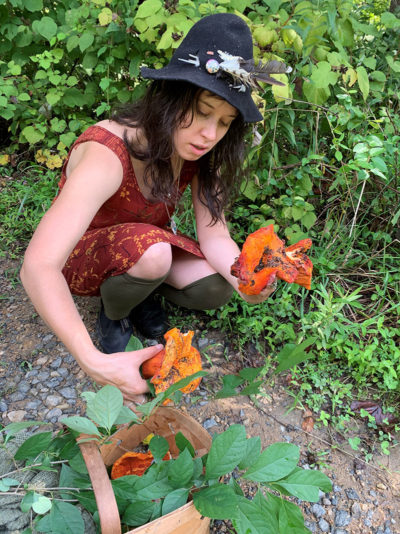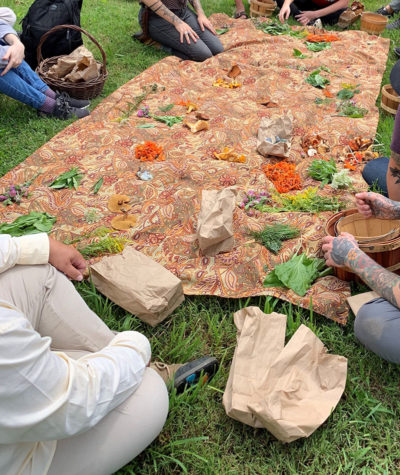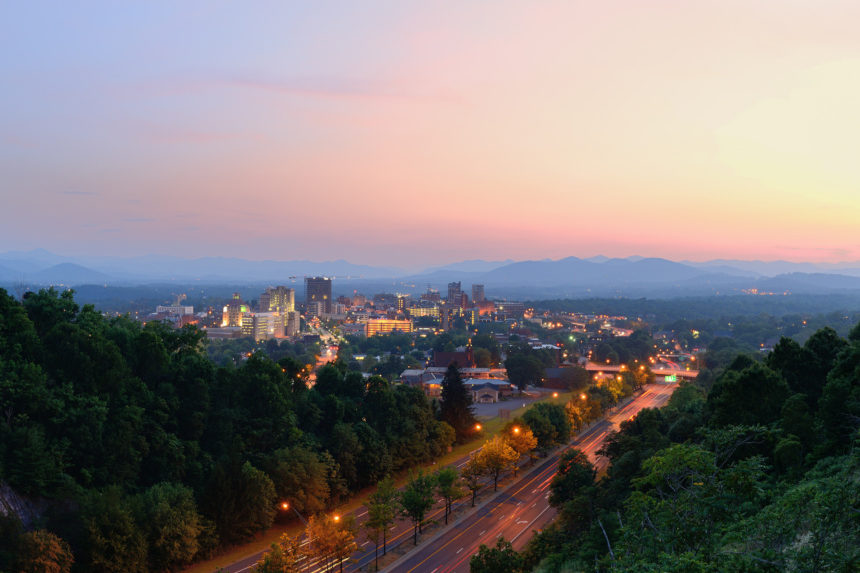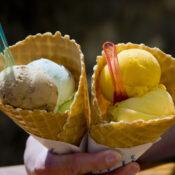To a northerner like myself, Asheville, North Carolina, evokes the feel of small towns in Vermont or Maine. Nestled in the French Broad River Valley in the Blue Ridge mountains at 2100 feet above sea level, the town is a comfortable marriage between a kind of hip, escape-from-the-rat-race vibe and southern charm. You go to Asheville to enjoy the arts, crafts, beer and food, and also to go hiking and biking in the surrounding hills. A creative air suffuses it all: Everyone you meet, it seems, is either an artist, writer, brewmaster or chef. Tattoos abound.
As for shopping: wonderful, quirky, and super-local. As a general principle, you won’t find chain stores here. It’s not that there’s an ordinance blocking them, but rather that their presence is gently and sometimes aggressively discouraged. Pickets marched up and down in front of Urban Outfitters a few years ago when it first opened. (Apparently the same censure does not apply to sugary treats: Ben and Jerry’s had no such problems setting up shop.)
My wife Estelle and I pulled into town on a Monday in early August and stayed at the centrally located AC Marriott Hotel. This is a modern property with rooms that are light and airy. At nine stories, the building is tall for Asheville. The top floor is an elegant restaurant with an outdoor seating area allowing expansive views.
Our dinner that first evening was at Limones, a Mexican-themed restaurant that is a sophisticated affair, not at all like your local taco joint, where San Francisco-trained chef Hugo Ramirez gives a modern twist to traditional Mexican fare. After an appetizer of ceviche and a fresh tuna sampler, we selected main courses of salmon, and another of scallops in a broth with corn. Delicious food, and you couldn’t help noticing the place was packed to the gills even at 9 p.m. on a Monday night.
The next morning, we were off to the arts district, where a series of 22 industrial buildings and warehouses are spread out for a mile along the French Broad River. More than 200 artists occupy these spaces as part of the city’s effort both to boost the arts and reclaim what had been a decaying part of town. Among the newest are Wilma Dykeman Greenway and Black Wall Street. Pottery seemed to predominate in many of the studios, but there are also paintings on display as well as metalwork, fiber, glass, and paper art.
For the afternoon, we embarked on the “Eating Asheville” food tour, which involves marching around for two-and-a-half hours, stopping along the way at local eateries for a bite here, a nibble there, and a sip in between. First stop was the eclectic Battery Park Book Exchange, which features 80,000 lightly used books for sale as well as a wine and champagne bar. There, we drank sparkling wine while browsing the book collection, arranged by theme. Treasures abound. Under Civil War history, I stumbled across War is Hell! by General Sherman, an extraordinary journal of his march to Atlanta, including photo plates. In the Western section, I can’t resist The Complete Western Stories of Elmore Leonard. The writer of Get Shorty and countless other modern crime novels got his start writing western stories for the pulp magazines. I pick it up for about 10 bucks, which is probably about what Leonard got paid per story back in the ’50s. Still, his clean and precise early writing, mainly about soldiers stationed in army garrisons out West and their Native American partners (and sometime adversaries) presages his later popularity.
The bookstore is located in Grove Arcade, which also houses several other shops, including, get this: Adoratherapy where you can book a personalized aura portrait for you and your pet, along with a bespoke, hand-mixed aromatherapy regimen, should that be to your taste, as well as Wake Foot Sanctuary, which promises to elevate the foot soak to an art form.

The arcade was built by one of Asheville’s most noted developers, E.W. Grove, who also constructed the elegant Grove Park Inn at the edge of town. The three-story arcade, one of America’s first shopping malls, is a late gothic revival building featuring an exterior that includes a series of grotesques (distinct from gargoyles in that they are purely decorative and don’t have water spouts) said to be modeled on the face of a debtor who owed Grove around $200. “A precursor to Facebook shaming” suggests Kaycee, our guide, as she led us out onto the street to begin our food tour. Over the next couple of hours, we stopped in a half dozen restaurants, sampling dishes ranging from Indian curry to pulled pork to ravioli to tacos. For a finale, we savored brownies topped with single-source chocolate at French Broad Chocolate Lounge. Good thing some walking was involved!
The evening belonged to Isis Restaurant and Dinner Hall in West Asheville. This is more of a music venue in design, with tables facing a large stage, and if you expect the food to be standard bar fare like burgers and wings, you’d be wrong. This is Asheville, remember, so the plaintive sounds of bluegrass music are paired with exquisite ahi tuna or trout stuffed with herbs.

The next morning, it was off on a foraging tour with a No Taste Like Home, which is part hike, part botany lesson, with a focus on the edible. About a dozen participants gathered at a modest farm about 25 minutes west of Asheville where Becky, a trained botanist, guided us on our trek into the nearby countryside. We stopped every few dozen yards for a little talk about a given plant – and to nibble on it. The gist is that there’s food all around us. We learned, for example, that plain old Pennsylvania smart weed (which we learn to ID by the little hairs on the stem) has leaves that can be fried into chips; that you can safely eat all segmented berries, not just the obvious wild blackberries and raspberries; that jewel weed has healing properties; that goldenrod has a carrot-like flavor; and that the tea made from queen Anne’s lace is good for arthritis.

Noshing on leaves, stems, and the occasional root is all well and good, but it quickly became clear that the group’s main interest is mycology. Becky quickly gave in to the mushroom energy and guided us up a trail where we soon found plenty. “Don’t pick anything white,” she warned.
Heeding her advice, we filled our bags with tiny orange chanterelles and also tawny milkcap mushrooms, indigo milkcap mushrooms (which look deadly as hell, but are edible), painted boletes, and huge, malformed (as if by a nuclear accident) lobster mushrooms. The latter is not technically a mushroom, but rather a parasitic fungus that grows on certain other mushrooms and has a reddish color like a cooked lobster as well as a faint seafood odor and flavor.
After a few hours of hunting and gathering, Becky and her assistant rolled out a blanket and we dumped and sorted our finds. A camping stove was lit and one of the giant lobster mushrooms was cut up and fried in butter. Creamy and delicious.
The next day, we paid a visit to Asheville’s crown jewel, Biltmore, just outside of town. It was built in 1895 by George Vanderbilt, the youngest child of the famed industrialist William Henry Vanderbilt, and grandson of patriarch Cornelius, as a retreat reminiscent of the grand castles and estates of France and Britain. Vanderbilt fell in love with the North Carolina mountains after visiting with his mother in the late 1880s and immediately began acquiring land there. By late 1889, he was ready to build his dream house, bringing together two of the leading architects of the age, Richard Morris Hunt (best known for designing the façade and entrance hall of New York’s Metropolitan Museum) and Frederick Law Olmstead (the father of American landscape architecture, and the architect of New York’s Central Park). 2022 marks the 200th anniversary of Olmstead’s birthday and numerous events are planned to honor his memory.

On a tour of the extraordinary 178,000 square foot house set on 125,000 acres, you are escorted back 100 years to the gilded age. One first enters the dining hall with 70 foot ceilings where formal dinners once featured men in white tie and tails and women in evening gowns.
The tour takes visitors through sumptuous sitting rooms, breakfast halls, a music room, a walnut sided library with 10,000 books, a gallery featuring fine Flemish tapestries. Along the way, Vanderbilt’s art collection includes Ming dynasty urns, Durer prints, a portrait of Washington by John Singer Sargent, a portrait of Vanderbilt’s wife Edith by Whistler, collections of Japanese art and more.
So, what’s not to like about this lovely southern town? Some fear it is in danger of becoming a victim of its own success: Too many tourists, traffic jams, soaring real estate prices. To slow the town’s growth spurt, in September of 2019 the city council voted to put a moratorium on approvals for new hotels. The moratorium was lifted in 2021, with the condition that new hotels must devote some funds to affordable housing.
Yes, Asheville can get a bit crowded, especially in its peak seasons of spring and fall, but it’s easy to see why it is so beloved. The climate, the artsy vibe, the fine food and brewpub scene. It’s the kind of place where, once you’ve visited, you can’t help dreaming of coming back again.
This is a revised and updated version of a story that was originally posted in January of 2020.
Featured image: Shutterstock
Become a Saturday Evening Post member and enjoy unlimited access. Subscribe now




Comments
I am a native of Asheville and due to divorce I moved away 4 years ago. I can not believe what I am reading about my hometown. All I can say is who you vote for matters. Seems like those extreme liberals you guys are now voting in do not know how to keep our much loved area safe and managed properly. Maybe I should move back home and run for mayor. I love Asheville and would hate to see it go to ruins.
Vote well folks.
Jamie
We built our dream home in AVL 7 years ago. That was then and now we couldn’t wait to leave the damn place. Trash and beggars everywhere, the food isn’t all that, but you will surely pay for it. The local government is out of their minds and only concerned about one thing, money. Here’s the only thing I miss, a few good authentic beers and the trails.
Wow, love traveling through the eyes of the well to do. Asheville is a horrible horrible place if you can not afford the security that comes with luxury. Then best advice is don’t come! The city council decided to dedund much needed drug grants for their or better yet your “river arts district”. If you do decide to take a stroll make sure its during business hours with plenty of daylight. If you look close there is homeless camps in the ally ways even in the high brush you stroll right by. Asheville is not considered “Bee city” “Beer city” “Arts city” the people here call it Trashville!
Asheville is definitely an amazing destination for a vacation without question. It seems like a wonderful fusion of the South and Northeast, and with the Biltmore estate, a taste of Europe too. I’d want to see everything, but particularly the Japanese art. I could see spending hours there.
I’m sure the spring and fall must be the nicest times because of the weather. The crowds would still be better than L.A. Love the Limones Restaurant already after looking at the menu listings. The Indian restaurant too. Most of all though the beautiful scenery, naturally.